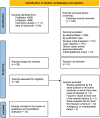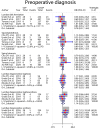Incidence and risk factors of new-onset sacroiliac joint pain after spinal surgery: a systematic review and meta-analysis
- PMID: 39346039
- PMCID: PMC11439385
- DOI: 10.7717/peerj.18083
Incidence and risk factors of new-onset sacroiliac joint pain after spinal surgery: a systematic review and meta-analysis
Abstract
Purpose: A systematic review and meta-analysis for incidence and risk factors of new-onset sacroiliac joint pain (SIJP) after spinal surgery aimed to provide evidence-based medical references for its early prevention, timely intervention, and appropriate treatment.
Methodology: The protocol of the systematic review and meta-analysis was registered in the International Prospective Register of Systematic Review (PROSPERO) with the PROSPERO ID (CRD42023463177). Relevant studies were searched to January 2024 from the databases of PubMed, Embase, Cochrane Library, and Web of Science, and the types of studies were cohort studies, case-control studies, and cross-sectional studies. Study quality was assessed using the Newcastle-Ottawa Scale (NOS) and the Cross-Sectional/Prevalence Study Quality recommended by the Agency for Healthcare Research and Quality (AHRQ). Two authors conducted studies search, data extraction, and quality assessment independently. Meta-analyses were done using Stata 14.0 software.
Results: Twelve observational studies with 3,570 spinal surgery patients were included. Ten were case-control studies, one was a cross-sectional study, and another was a cohort study, all of which were of moderate quality and above. The results of the meta-analysis showed that the incidence of new-onset SIJP after spinal surgery was 9.40%; females, no. of surgical segments, fusion to the sacrum, and postoperative pelvic tilt (PT) were significantly associated with the new-onset SIJP after spinal surgery. Meta-analyses for preoperative and postoperative controls of spondylopelvic parameters showed that postoperative lumbar lordosis (LL) in the SIJP group and postoperative LL and sacral slope (SS) of patients in the NoSIJP group had significant differences from preoperative.
Conclusion: Available evidence suggests that an increased risk of new-onset SIJP after spinal surgery is associated with sex, multi-segmental surgery, fusion to the sacrum, and greater postoperative PT.
Keywords: Incidence; Meta-analysis; Risk factors; Sacroiliac joint pain; Systematic review.
© 2024 Xu et al.
Conflict of interest statement
The authors declare that they have no competing interests.
Figures











Similar articles
-
The association between sacroiliac joint-related pain following lumbar spine surgery and spinopelvic parameters: a prospective multicenter study.Eur Spine J. 2019 Jul;28(7):1603-1609. doi: 10.1007/s00586-019-05952-z. Epub 2019 Mar 18. Eur Spine J. 2019. PMID: 30887220 Clinical Trial.
-
Risk Factors of Postoperative Sacroiliac Joint Pain for Posterior Lumbar Surgery: ≥2-Year Follow-up Retrospective Study.World Neurosurg. 2018 Feb;110:e546-e551. doi: 10.1016/j.wneu.2017.11.053. Epub 2017 Nov 20. World Neurosurg. 2018. PMID: 29158098
-
Fusion of Multiple Segments Can Increase the Incidence of Sacroiliac Joint Pain After Lumbar or Lumbosacral Fusion.Spine (Phila Pa 1976). 2016 Jun;41(12):999-1005. doi: 10.1097/BRS.0000000000001409. Spine (Phila Pa 1976). 2016. PMID: 26689576
-
Incidence of sacroiliac joint pain after lumbosacral spine fusion: A systematic review.Neurochirurgie. 2023 Mar;69(2):101419. doi: 10.1016/j.neuchi.2023.101419. Epub 2023 Feb 6. Neurochirurgie. 2023. PMID: 36754146
-
Sacroiliac Joint Fusion Methodology - Minimally Invasive Compared to Screw-Type Surgeries: A Systematic Review and Meta-Analysis.Pain Physician. 2019 Jan;22(1):29-40. Pain Physician. 2019. PMID: 30700066
References
-
- Abouzeid W. Sacroiliac joint pain after lumbo-sacral fusion: incidence and management modalities. Egyptian Spine Journal. 2016;18(1):28–38. doi: 10.21608/esj.2016.3987. - DOI
-
- Barrey C, Jund J, Noseda O, Roussouly P. Sagittal balance of the pelvis-spine complex and lumbar degenerative diseases. A comparative study about 85 cases. European Spine Journal: Official Publication of the European Spine Society, the European Spinal Deformity Society, and the European Section of the Cervical Spine Research Society. 2007;16(9):1459–1467. doi: 10.1007/s00586-006-0294-6. - DOI - PMC - PubMed
-
- Barrey C, Roussouly P, Le Huec JC, D’Acunzi G, Perrin G. Compensatory mechanisms contributing to keep the sagittal balance of the spine. European Spine Journal: Official Publication of the European Spine Society, the European Spinal Deformity Society, and the European Section of the Cervical Spine Research Society. 2013;22(Suppl 6):S834–S841. doi: 10.1007/s00586-013-3030-z. - DOI - PMC - PubMed
Publication types
MeSH terms
LinkOut - more resources
Full Text Sources

